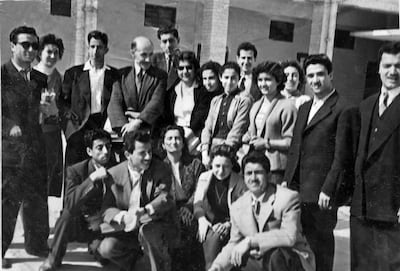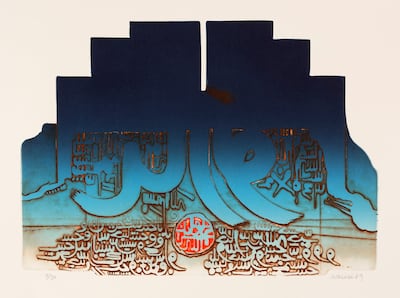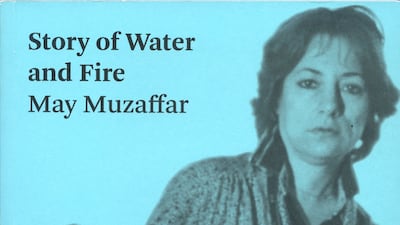May Muzaffar’s remarkable memoir Story of Water and Fire begins as a love story between a young Iraqi woman and her artist suitor. He vacillates; her mother equivocates; Muzaffar bides her time. Ultimately, they find themselves in an “ideal marriage” – a meeting of minds where she writes and he paints.
Muzaffar and her husband, the painter and printmaker Rafa Nasiri, were key figures in the 1970s generation of Iraqi art. The couple travelled together frequently, with Nasiri showing internationally at places such as the Asilah Arts Festival in Morocco, while Muzaffar wrote poetry, short stories and criticism that chronicled this exciting time in the chapter of Arab art.
Published last year, Story of Water and Fire is part tale of this cultural milieu, and part a requiem for a country destroyed by conflict. Muzaffar and Nasiri remained in Baghdad throughout the Iran-Iraq War and the Gulf War, but left afterwards for Jordan and watched the 2003 invasion from afar. Muzaffar still lives in Amman, where she still runs the Studio Nasiri even though her husband died 11 years ago.
When they first met in early 1971, Muzaffar worked at an insurance company in the Iraqi capital. Nasiri and Dia Azzawi (another pioneer of Iraqi art and sculpture) had been commissioned to paint murals in the building. Her office was on the ninth floor, and Nasiri would climb the stairs – as the lift was not yet installed – to hand-deliver openings to exhibitions and activities at the arts centre, or find other pretexts to come to talk to her.
“I loved his work before I fell in love with him,” Muzaffar tells The National. “At the time, freedom in society was limited. My family was well-known. He was known also as an artist, as was his family. We had to do everything in secret. We used to speak on the phone all the time.”
When they married, Nasiri transformed his studio attached to his family house into an apartment for the two of them. They had fruit trees in the garden and hosted Iraqi poets and artists, such as Azzawi and Saleh Al-Jumaie.
The artists of this period, some of whom are referred to as the New Vision group, wanted to give a “fresh look”, Muzaffar says, to Iraqi identity, inspired by the country's heritage. Spurred on by the Six-Day War, which took place between Arab states and Israel in 1967, they also looked to pan-Arabism, playing with the form of the Arabic letter.
“May was just starting in the 1970s but quickly became an important critic because of her sensitivities to the art scene,” Iraqi-British art historian Nada Shabout tells The National. “She had a good eye for detail. Because of her relationship with Rafa, she witnessed first-hand what was developing, and delivered analysis and context around it.”
These artistic ambitions were well supported by the Iraqi state, which had long offered bursaries for writers and artists and acquired work for its public museums. In 1972, Baghdad hosted the Al-Wasiti Fine Arts Festival and, two years later, the Baghdad Biennial for Arab Art, which convened artists from across the region and cemented the city's prominent cultural role.
“We owe much of our knowledge of the history of the period to her writings,” says Shabout.
The wartime years
Muzaffar's memoir makes a substantial contribution to literature around the Iraq war with its bravura account of life under the 1991 US bombardment.
It begins when Muzaffar and Nasiri were living in a house in the suburbs, which they had designed in modern style with an architect. As Muzaffar vividly describes, they spent the first night of the war in a corner beside their kitchen.
The next day, they passed on their neighbour’s invitation to join him and his family in the bomb shelter he had erected in his new house. Instead, they drove through the quiet afternoon – the air strikes took place at night – to Muzaffar's brother’s house, so that the family could be together.
“We were nine people living in a house with no electricity and no water other than what was in the tank,” Muzaffar recalls. A few weeks later, the affluent neighbourhood next to them was struck, and the whole family decided to decamp to Muzzafar and Nasiri's home in the suburbs. They rode out of the rest of the war in the modernist house, rationing food, water and paraffin.
The sequences about the 1991 invasion are particularly important because few Iraqi accounts of the period have been published in English (though more have recently emerged in the past five years). Muzaffar deftly frames not only the US bombardment but also the rapid decline of the country afterwards, the emotional tensions of life in the diaspora, and the complicated process of realising they would never return.
Like many, Muzaffar and Nasiri wanted to stay in Iraq after the war, but the security situation was too difficult. They left for Amman, which functioned as a refuge for Iraq's displaced art scene. They left their house, which contained Nasiri’s paintings and their substantial library, and paid a caretaker to look after it.
A few years after the 2003 invasion, they received a call from a neighbour: the house had been trashed and a strange car was parked in the driveway. They learnt that their caretaker had been killed some time ago at a military checkpoint. The new inhabitant had cleared out the rooms, which were by then infested with insects and animals, but carefully looked after the artworks and books.
They let him stay, but set about moving artworks to Amman. Princess Wijdan Ali, then head of the Royal Society of Fine Arts, offered to host a retrospective of Nasiri’s work – which gave the works the pretexts for exit papers – and at last Nasiri's art left Baghdad. They gave their impressive library to a friend.
Nasiri died in 2013 in Amman, and Muzaffar began writing the book soon after – initially, as a process of mourning, she says. She wrote it over the course of seven years, and it was first published in Arabic in Beirut. The English edition, translated by Jennifer Leigh Peterson, now appears as part of an initiative set up by Al Mawrid Arab Centre for the Study of Art at NYU Abu Dhabi.
“Muzaffar's book is the first in a series of translations of memoirs or primary documents written and published in Arabic,” says Salwa Mikdadi, who founded Al Mawrid. “Prior to the 1990s, the majority of books on Arab art were written and published in Arabic. Through these translations, Al Mawrid offers wider access to key primary texts on the development of visual art in the Arab world.”
The centre is now working on three more volumes.
For Muzaffar, the book was not only a chance to revisit her life with Nasiri but also to educate a new generation, particularly with the English translation.
She included a number of details, such as an air strike in which 400 civilians taking sanctuary in a nuclear shelter were killed, because she realises how little people outside Iraq still know about the war.
“Many Americans, they don't even know about” the Amiriyah strike or what the war was like, she says. “So that's why I put everything in there – and in a simple way.”
The National Archives, Abu Dhabi
Founded over 50 years ago, the National Archives collects valuable historical material relating to the UAE, and is the oldest and richest archive relating to the Arabian Gulf.
Much of the material can be viewed on line at the Arabian Gulf Digital Archive - https://www.agda.ae/en
The specs
Engine: 2.0-litre 4cyl turbo
Power: 261hp at 5,500rpm
Torque: 405Nm at 1,750-3,500rpm
Transmission: 9-speed auto
Fuel consumption: 6.9L/100km
On sale: Now
Price: From Dh117,059
The candidates
Dr Ayham Ammora, scientist and business executive
Ali Azeem, business leader
Tony Booth, professor of education
Lord Browne, former BP chief executive
Dr Mohamed El-Erian, economist
Professor Wyn Evans, astrophysicist
Dr Mark Mann, scientist
Gina MIller, anti-Brexit campaigner
Lord Smith, former Cabinet minister
Sandi Toksvig, broadcaster
Sly%20Cooper%20and%20the%20Thievius%20Raccoonus
%3Cp%3E%3Cstrong%3EDeveloper%3A%3C%2Fstrong%3E%20Sucker%20Punch%20Productions%3Cbr%3E%3Cstrong%3EPublisher%3A%3C%2Fstrong%3E%20Sony%20Computer%20Entertainment%3Cbr%3E%3Cstrong%3EConsole%3A%3C%2Fstrong%3E%20PlayStation%202%20to%205%3Cbr%3E%3Cstrong%3ERating%3A%3C%2Fstrong%3E%205%2F5%3C%2Fp%3E%0A
Sui Dhaaga: Made in India
Director: Sharat Katariya
Starring: Varun Dhawan, Anushka Sharma, Raghubir Yadav
3.5/5
The National's picks
4.35pm: Tilal Al Khalediah
5.10pm: Continous
5.45pm: Raging Torrent
6.20pm: West Acre
7pm: Flood Zone
7.40pm: Straight No Chaser
8.15pm: Romantic Warrior
8.50pm: Calandogan
9.30pm: Forever Young
Company profile
Name: Back to Games and Boardgame Space
Started: Back to Games (2015); Boardgame Space (Mark Azzam became co-founder in 2017)
Founder: Back to Games (Mr Azzam); Boardgame Space (Mr Azzam and Feras Al Bastaki)
Based: Dubai and Abu Dhabi
Industry: Back to Games (retail); Boardgame Space (wholesale and distribution)
Funding: Back to Games: self-funded by Mr Azzam with Dh1.3 million; Mr Azzam invested Dh250,000 in Boardgame Space
Growth: Back to Games: from 300 products in 2015 to 7,000 in 2019; Boardgame Space: from 34 games in 2017 to 3,500 in 2019
THE CLOWN OF GAZA
Director: Abdulrahman Sabbah
Starring: Alaa Meqdad
Rating: 4/5
From Europe to the Middle East, economic success brings wealth - and lifestyle diseases
A rise in obesity figures and the need for more public spending is a familiar trend in the developing world as western lifestyles are adopted.
One in five deaths around the world is now caused by bad diet, with obesity the fastest growing global risk. A high body mass index is also the top cause of metabolic diseases relating to death and disability in Kuwait, Qatar and Oman – and second on the list in Bahrain.
In Britain, heart disease, lung cancer and Alzheimer’s remain among the leading causes of death, and people there are spending more time suffering from health problems.
The UK is expected to spend $421.4 billion on healthcare by 2040, up from $239.3 billion in 2014.
And development assistance for health is talking about the financial aid given to governments to support social, environmental development of developing countries.
KILLING OF QASSEM SULEIMANI
The%20Iron%20Claw
%3Cp%3E%3Cstrong%3EDirector%3A%3C%2Fstrong%3E%20Sean%20Durkin%C2%A0%3C%2Fp%3E%0A%3Cp%3E%3Cstrong%3EStarring%3A%3C%2Fstrong%3E%20Zac%20Efron%2C%20Jeremy%20Allen%20White%2C%20Harris%20Dickinson%2C%20Maura%20Tierney%2C%20Holt%20McCallany%2C%20Lily%20James%3C%2Fp%3E%0A%3Cp%3E%3Cstrong%3ERating%3A%3C%2Fstrong%3E%204%2F5%3C%2Fp%3E%0A
The specs: 2019 Mercedes-Benz C200 Coupe
Price, base: Dh201,153
Engine: 2.0-litre turbocharged four-cylinder
Transmission: Nine-speed automatic
Power: 204hp @ 5,800rpm
Torque: 300Nm @ 1,600rpm
Fuel economy, combined: 6.7L / 100km
Five%20calorie-packed%20Ramadan%20drinks
%3Cp%3E%3Cstrong%3ERooh%20Afza%3C%2Fstrong%3E%0D%3Cbr%3E100ml%20contains%20414%20calories%0D%3Cbr%3E%3Cstrong%3ETang%20orange%20drink%3C%2Fstrong%3E%0D%3Cbr%3E100ml%20serving%20contains%20300%20calories%0D%3Cbr%3E%3Cstrong%3ECarob%20beverage%20mix%3C%2Fstrong%3E%0D%3Cbr%3E100ml%20serving%20contains%20about%20300%20calories%0D%3Cbr%3E%3Cstrong%3EQamar%20Al%20Din%20apricot%20drink%3C%2Fstrong%3E%0D%3Cbr%3E100ml%20saving%20contains%2061%20calories%0D%3Cbr%3E%3Cstrong%3EVimto%20fruit%20squash%3C%2Fstrong%3E%0D%3Cbr%3E100ml%20serving%20contains%2030%20calories%3C%2Fp%3E%0A
Price, base / as tested From Dh173,775 (base model)
Engine 2.0-litre 4cyl turbo, AWD
Power 249hp at 5,500rpm
Torque 365Nm at 1,300-4,500rpm
Gearbox Nine-speed auto
Fuel economy, combined 7.9L/100km
Key facilities
- Olympic-size swimming pool with a split bulkhead for multi-use configurations, including water polo and 50m/25m training lanes
- Premier League-standard football pitch
- 400m Olympic running track
- NBA-spec basketball court with auditorium
- 600-seat auditorium
- Spaces for historical and cultural exploration
- An elevated football field that doubles as a helipad
- Specialist robotics and science laboratories
- AR and VR-enabled learning centres
- Disruption Lab and Research Centre for developing entrepreneurial skills
UAE currency: the story behind the money in your pockets
'Downton Abbey: A New Era'
Director: Simon Curtis
Cast: Hugh Bonneville, Elizabeth McGovern, Maggie Smith, Michelle Dockery, Laura Carmichael, Jim Carter and Phyllis Logan
Rating: 4/5
Chatham House Rule
A mark of Chatham House’s influence 100 years on since its founding, was Moscow’s formal declaration last month that it was an “undesirable
organisation”.
The depth of knowledge and academics that it drew on
following the Ukraine invasion had broadcast Mr Putin’s chicanery.
The institute is more used to accommodating world leaders,
with Nelson Mandela, Margaret Thatcher among those helping it provide
authoritative commentary on world events.
Chatham House was formally founded as the Royal Institute of
International Affairs following the peace conferences of World War One. Its
founder, Lionel Curtis, wanted a more scientific examination of international affairs
with a transparent exchange of information and ideas.
That arena of debate and analysis was enhanced by the “Chatham
House Rule” states that the contents of any meeting can be discussed outside Chatham
House but no mention can be made identifying individuals who commented.
This has enabled some candid exchanges on difficult subjects
allowing a greater degree of free speech from high-ranking figures.
These meetings are highly valued, so much so that
ambassadors reported them in secret diplomatic cables that – when they were
revealed in the Wikileaks reporting – were thus found to have broken the rule. However,
most speeches are held on the record.
Its research and debate has offered fresh ideas to
policymakers enabling them to more coherently address troubling issues from climate
change to health and food security.
Fixture and table
UAE finals day: Friday, April 13 at Rugby Park, Dubai Sports City
- 3pm, UAE Conference: Dubai Tigers v Sharjah Wanderers
- 6.30pm, UAE Premiership: Dubai Exiles v Abu Dhabi Harlequins
UAE Premiership – final standings
- Dubai Exiles
- Abu Dhabi Harlequins
- Jebel Ali Dragons
- Dubai Hurricanes
- Dubai Sports City Eagles
- Abu Dhabi Saracens
THE SPECS
Engine: 3-litre V6
Transmission: eight-speed automatic
Power: 424hp
Torque: 580 Nm
Price: From Dh399,000
On sale: Now
LIVING IN...
This article is part of a guide on where to live in the UAE. Our reporters will profile some of the country’s most desirable districts, provide an estimate of rental prices and introduce you to some of the residents who call each area home.
FINAL RESULT
Sharjah Wanderers 20 Dubai Tigers 25 (After extra-time)
Wanderers
Tries: Gormley, Penalty
cons: Flaherty
Pens: Flaherty 2
Tigers
Tries: O’Donnell, Gibbons, Kelly
Cons: Caldwell 2
Pens: Caldwell, Cross
Sole survivors
- Cecelia Crocker was on board Northwest Airlines Flight 255 in 1987 when it crashed in Detroit, killing 154 people, including her parents and brother. The plane had hit a light pole on take off
- George Lamson Jr, from Minnesota, was on a Galaxy Airlines flight that crashed in Reno in 1985, killing 68 people. His entire seat was launched out of the plane
- Bahia Bakari, then 12, survived when a Yemenia Airways flight crashed near the Comoros in 2009, killing 152. She was found clinging to wreckage after floating in the ocean for 13 hours.
- Jim Polehinke was the co-pilot and sole survivor of a 2006 Comair flight that crashed in Lexington, Kentucky, killing 49.
Various Artists
Habibi Funk: An Eclectic Selection Of Music From The Arab World (Habibi Funk)




